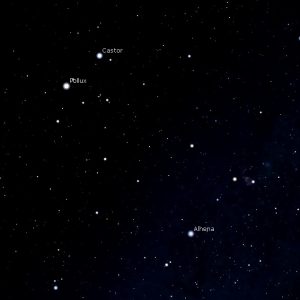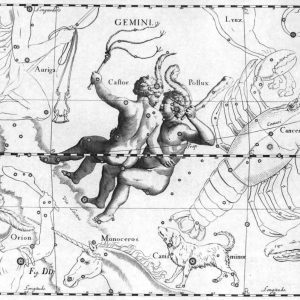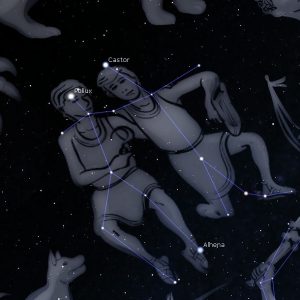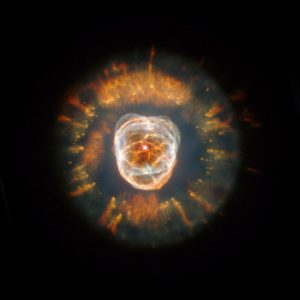Constellation Gemini
At the moment, planet Mars is a bright orange beacon, high in the southern sky.
Today we’ll look at the stars behind the red planet.
They are the stars of constellation Gemini.

Gemini: Stellarium
As ever, if you want to locate Gemini in the sky, please look to Stellarium.
You can get the free download of this superb software here.
The Constellation
Gemini is one of Ptolemy’s original 48 star patterns from 2 AD.
It became one of the modern 88 constellations.

It is also one of the twelve signs of the Zodiac.
These are constellations through which the Sun, moon and planets track across our sky.
Mythology

Castor & Pollux, the Gemini twins
In Greek mythology, Gemini is named for the twins, Castor and Pollux.
Although they were twins, their family history was rather bizarre.
The Gemini twins were half-brothers.
They had the same mother but different fathers.
Their mother was Leda, queen of Sparta.
She was married to Tyndareus, the Spartan king.
He was father to Castor, who was therefore mortal.
But Leda was seduced by Zeus, king of the gods, in the form of a swan.
Pollux was his offspring and was a god himself and immortal.
To add to the strange ancestry, two daughters were conceived at the same time.
They were Clytemnestra and the beautiful Helen of Troy.
Castor and Pollux became associated with the protection of sailors.
They appeared at sea as St Elmo’s Fire.
When Castor’s death eventually approached, Pollux asked Zeus to make him a god.
They were placed together in the sky as the heavenly twins.
The stars
Together, the stars of Gemini form two stick men in outline.
The stars Castor and Pollux are the heads of the men, with Castor above and Pollux below.

Gemini artwork: Stellarium
Castor
Castor is relatively close, about 50 light years from Earth.
It appears as a bright blue-white star to our eyes.
Bu it is in fact made of six stars in three pairs.
The two brightest orbit each other and are bigger and brighter than our Sun.
The others are much dimmer and include a couple of red dwarf stars.
Pollux
Pollux is slightly brighter than Castor and slightly closer at 34 light years.
It is very different to its twin.
Pollux is a red giant, approaching the end of its life.
It is about ten times wider than the Sun.
Pollux has an exoplanet in orbit around it.
This planet, named Thestias, is three times bigger than Jupiter.
Deep Sky

Gemini, M35 and Eskimo Nebula: Stellarium
M35
M35 is a lovely open cluster of 200 stars.
It lies around 2,800 light years from Earth.
It can be picked up in binoculars and is great at low power in a telescope.

M35: NASA / ESA
Eskimo Nebula
The Eskimo Nebula is a star in its death throes.
The star is blowing its outer layers into space.
All that will remain is the middle, a dead white dwarf.

Eskimo Nebula: NASA / HST
The white dwarf is at the centre of the image.
The material blown out resembles an Eskimo’s parka, hence the name.
Meteor Shower
Gemini is the centre point of the Geminid meteor display every December.
The shower peaks on the night of December 13 to 14.
It is one of the best annual displays, with up to 100 shooting stars an hour.

The author: Dennis Ashton is a Fellow of the Royal Astronomical Society and a Wonderdome presenter.
In 2024, Dennis received the Special Contribution award from the British Association of Planetaria.
Wonderdome now has 14 presenters, making us the largest – and best – mobile planetarium organisation in the UK.
Would you like to hear more Astronomy news?
Do you want to to find out about our upcoming public events?
Follow WonderDome Portable Planetarium on Twitter and Facebook or go to our web site wonderdome.co.uk


